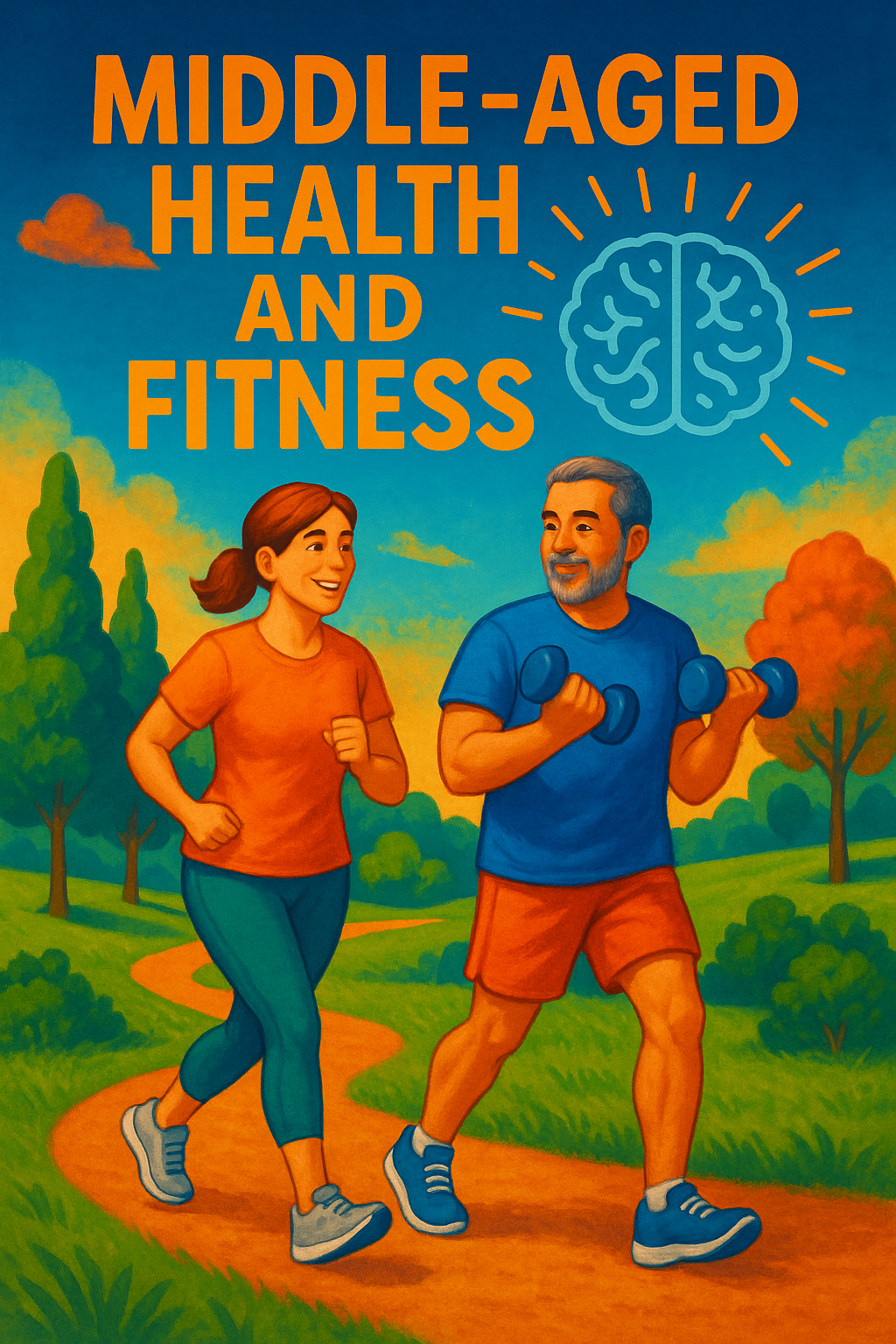status
date
slug
comment
summary
tags
category
icon
password
网址
type

Middle-aged health cover for exercise and alzheimer prevention
2025年最新研究显示,45-65岁期间增加体育锻炼可以显著降低阿尔茨海默病的风险。对于正处于人生关键阶段的中年人而言,这一发现具有重大意义。让我们深入了解运动如何成为大脑健康的守护者。
Latest research in 2025 shows that increasing physical exercise between ages 45-65 can significantly reduce the risk of Alzheimer's disease. For middle-aged people in a critical life stage, this finding has great significance. Let's delve into how exercise becomes a guardian of brain health.
最新科学研究发现 / Latest Scientific Research Findings
巴塞罗那全球健康研究所的最新研究追踪了337名中年人,发现遵循世界卫生组织运动建议的人群,大脑中β-淀粉样蛋白的积累明显减少。这种蛋白质的过度积累是阿尔茨海默病的主要病理特征。
The latest research from the Barcelona Institute for Global Health tracked 337 middle-aged people and found that those following WHO exercise recommendations had significantly reduced accumulation of beta-amyloid protein in their brains. Excessive accumulation of this protein is a major pathological feature of Alzheimer's disease.
beta-amyloid /ˈbiːtə ˈæməlɔɪd/ (n.β-淀粉样蛋白): 这种蛋白质在大脑中异常聚集,被认为是阿尔茨海默病发病的关键因素。
This protein abnormally accumulates in the brain and is considered a key factor in the development of Alzheimer's disease.
研究核心发现 / Core Research Findings:
- 13%的阿尔茨海默病病例可归因于缺乏运动 (13% of Alzheimer's cases can be attributed to lack of exercise)
- WHO建议:每周150-300分钟中等强度运动 (WHO recommendation: 150-300 minutes of moderate exercise per week)
- 运动对大脑病理学有直接积极影响 (Exercise has direct positive impact on brain pathology)
WHO运动标准的中年人实施方案 / Implementation Plan for WHO Exercise Standards for Middle-aged People
moderate-intensity exercise /ˈmɒdərət ɪnˈtensəti ˈeksəsaɪz/ (中等强度运动): 指运动时能够说话但不能唱歌的强度水平。
Refers to the intensity level where you can talk but cannot sing during exercise.
每周运动分配建议 / Weekly Exercise Distribution Recommendations:
方案一:平日模式 / Plan A: Weekday Mode
- 周一、三、五:45分钟快走或慢跑 (Monday, Wednesday, Friday: 45 minutes brisk walking or jogging)
- 周二、四:30分钟力量训练 (Tuesday, Thursday: 30 minutes strength training)
- 周末:60分钟户外活动(徒步、骑行)(Weekend: 60 minutes outdoor activities - hiking, cycling)
方案二:灵活模式 / Plan B: Flexible Mode
每天30分钟中等强度运动,可分为2-3次完成
30 minutes of moderate-intensity exercise daily, can be divided into 2-3 sessions
不同年龄段的运动调整 / Exercise Adjustments for Different Age Groups
45-50岁:活力建立期 / Ages 45-50: Vitality Building Phase
这个阶段身体机能相对较好,可以进行较高强度的运动:
Physical function is relatively good at this stage, allowing for higher intensity exercise:
cardiorespiratory fitness /ˌkɑːdioʊrɪˈspɪrətri ˈfɪtnəs/ (心肺适能): 重点提升心肺功能,为后续年龄的健康打下基础。
Focus on improving cardiopulmonary function to lay the foundation for health in later years.
- 推荐运动 (Recommended Exercise): 游泳、网球、足球、篮球
- Swimming, tennis, soccer, basketball
- 运动频率 (Exercise Frequency): 每周4-5次,每次45-60分钟
- 4-5 times per week, 45-60 minutes each time
51-60岁:稳定维持期 / Ages 51-60: Stable Maintenance Phase
开始注重运动的sustainability /səˌsteɪnəˈbɪləti/ (可持续性),减少高冲击运动,增加力量训练。
Begin to focus on exercise sustainability, reduce high-impact activities, increase strength training.
- 关节保护运动 (Joint-Protective Exercise): 水中有氧、椭圆机、瑜伽
- Water aerobics, elliptical machine, yoga
- 力量训练重点 (Strength Training Focus): 维持肌肉量,预防骨质疏松
- Maintain muscle mass, prevent osteoporosis
61-65岁:智慧调节期 / Ages 61-65: Wise Adjustment Phase
更加注重运动的安全性和针对性,cognitive enhancement /ˈkɒɡnətɪv ɪnˈhænsmənt/ (认知增强)成为重要目标。
Pay more attention to exercise safety and specificity, with cognitive enhancement becoming an important goal.
- 平衡训练 (Balance Training): 太极、平衡球、单腿站立练习
- Tai Chi, balance ball, single-leg standing exercises
- 协调性训练 (Coordination Training): 舞蹈、乒乓球
- Dancing, table tennis
运动对大脑的具体保护机制 / Specific Brain Protection Mechanisms of Exercise
neuroplasticity /ˌnʊroʊplæˈstɪsəti/ (n.神经可塑性): 运动通过促进神经可塑性,增强大脑适应和修复能力。
Exercise enhances the brain's ability to adapt and repair by promoting neuroplasticity.
保护机制详解 / Detailed Protection Mechanisms:
1. 血管健康改善 / Vascular Health Improvement
- 增加脑部血流量 (Increase cerebral blood flow)
- 降低血压和胆固醇 (Reduce blood pressure and cholesterol)
- 改善血管弹性 (Improve vascular elasticity)
2. 神经保护因子释放 / Neuroprotective Factor Release
BDNF (Brain-Derived Neurotrophic Factor) /breɪn dɪˈraɪvd ˌnʊroʊˈtrɒfɪk ˈfæktər/ (脑源性神经营养因子): 运动显著提升BDNF水平,促进神经元生长和存活。
Exercise significantly increases BDNF levels, promoting neuron growth and survival.
实用运动计划制定 / Practical Exercise Plan Development
个性化评估要素 / Personalized Assessment Elements:
current fitness level /ˈkɜːrənt ˈfɪtnəs ˈlevəl/ (当前健身水平): 通过简单测试评估基础体能。
Assess basic fitness through simple tests.
基础体能测试 / Basic Fitness Tests:
- 3分钟台阶测试(心肺功能)(3-minute step test for cardiopulmonary function)
- 俯卧撑测试(上肢力量)(Push-up test for upper body strength)
- 坐位体前屈(柔韧性)(Sit-and-reach test for flexibility)
渐进式训练原则 / Progressive Training Principles:
第1-2周:适应期 / Weeks 1-2: Adaptation Period
运动强度保持在最大心率的50-60%
Exercise intensity maintained at 50-60% of maximum heart rate
第3-6周:提升期 / Weeks 3-6: Improvement Period
逐渐增加到60-70%最大心率
Gradually increase to 60-70% of maximum heart rate
第7周以后:维持期 / Week 7 onwards: Maintenance Period
target heart rate /ˈtɑːrɡət hɑːrt reɪt/ (目标心率): 维持在70-80%最大心率范围
Maintain within 70-80% of maximum heart rate range
运动营养支持 / Exercise Nutritional Support
运动效果的最大化需要适当的营养支持:
Maximizing exercise effects requires appropriate nutritional support:
运动前营养 / Pre-exercise Nutrition:
- 复合碳水化合物:提供持续能量 (Complex carbohydrates: provide sustained energy)
- 适量蛋白质:支持肌肉功能 (Moderate protein: support muscle function)
运动后恢复 / Post-exercise Recovery:
antioxidants /ˌæntiˈɑːksɪdənts/ (n.抗氧化剂): 蓝莓、坚果等富含抗氧化剂的食物有助于减少运动后的炎症反应。
Foods rich in antioxidants like blueberries and nuts help reduce post-exercise inflammatory responses.
监测与调整 / Monitoring and Adjustment
健康指标监测 / Health Indicator Monitoring:
- 静息心率变化 (Resting heart rate changes)
- 睡眠质量改善 (Sleep quality improvement)
- 认知功能测试 (Cognitive function tests)
warning signs /ˈwɔːrnɪŋ saɪnz/ (警告信号): 如出现持续疲劳、关节疼痛或睡眠恶化,需及时调整运动计划。
If persistent fatigue, joint pain, or sleep deterioration occurs, exercise plans need timely adjustment.
结语:投资大脑健康的最佳时机 / Conclusion: The Best Time to Invest in Brain Health
中年期是投资大脑健康的黄金时期。科学研究明确告诉我们,规律的运动不仅能让我们保持身体健康,更能有效预防阿尔茨海默病,为晚年的生活质量提供强有力的保障。
Middle age is the golden period to invest in brain health. Scientific research clearly tells us that regular exercise not only keeps us physically healthy but also effectively prevents Alzheimer's disease, providing strong protection for quality of life in later years.
lifelong commitment /ˈlaɪflɔːŋ kəˈmɪtmənt/ (终生承诺): 将运动视为终生的健康投资,而非短期的减肥手段。
View exercise as a lifelong health investment, not a short-term weight loss method.
每一次心跳加速,每一滴汗水,都是在为未来的自己储蓄健康。从今天开始,让运动成为您中年生活中最重要的伙伴。
Every accelerated heartbeat, every drop of sweat, is saving health for your future self. Starting today, let exercise become the most important partner in your middle-aged life.
关键词 / Keywords:
中年人运动, 阿尔茨海默病预防, 大脑健康, 中年健身, 神经保护, middle-aged exercise, Alzheimer's prevention, brain health, midlife fitness, neuroprotection
<ins/>
转载本文或本站任何文章和资源请保留原文链接谢谢!
本站制作和创作会用到部分互联网资源,如果侵犯了您的合法权益,请参照关于页面联系本站我们会及时删除。
本站文章和一切内容仅供研究、学习交流之用,若使用商业用途,请联系站长授权。
欢迎您在底部评论区留言,一起交流~
<ins/>
- Author:FM
- URL:https://www.futuremedia.work/essay/Scientific-Guide-to-Exercise-for-Alzheimers-Prevention
- Copyright:All articles in this blog, except for special statements, adopt BY-NC-SA agreement. Please indicate the source!
Relate Posts
ChatGPT Tasks智能任务助手 / ChatGPT Tasks Smart Assistant

中国AI突破与全球竞争态势 / Chinese AI Breakthroughs and Global Competition

前列腺保健的科学锻炼指南 / Scientific Exercise Guide for Prostate Care

《深度思考》提升决策智慧 / "Deep Thinking" Enhancing Decision Wisdom

亚里士多德的实践智慧指引 / Aristotle's Practical Wisdom Guidance

Lesson6:The Environmental Health Investigation






